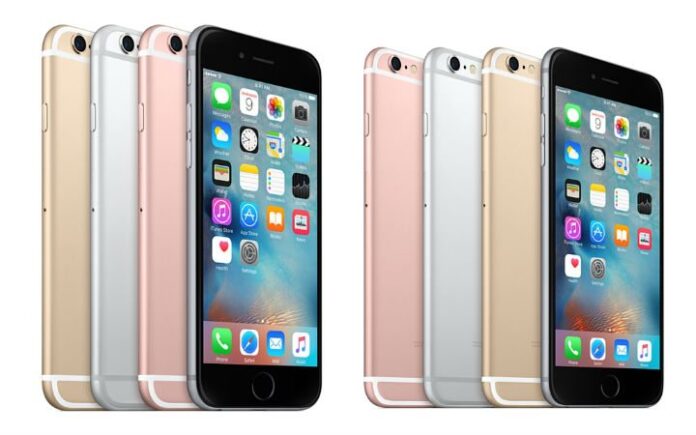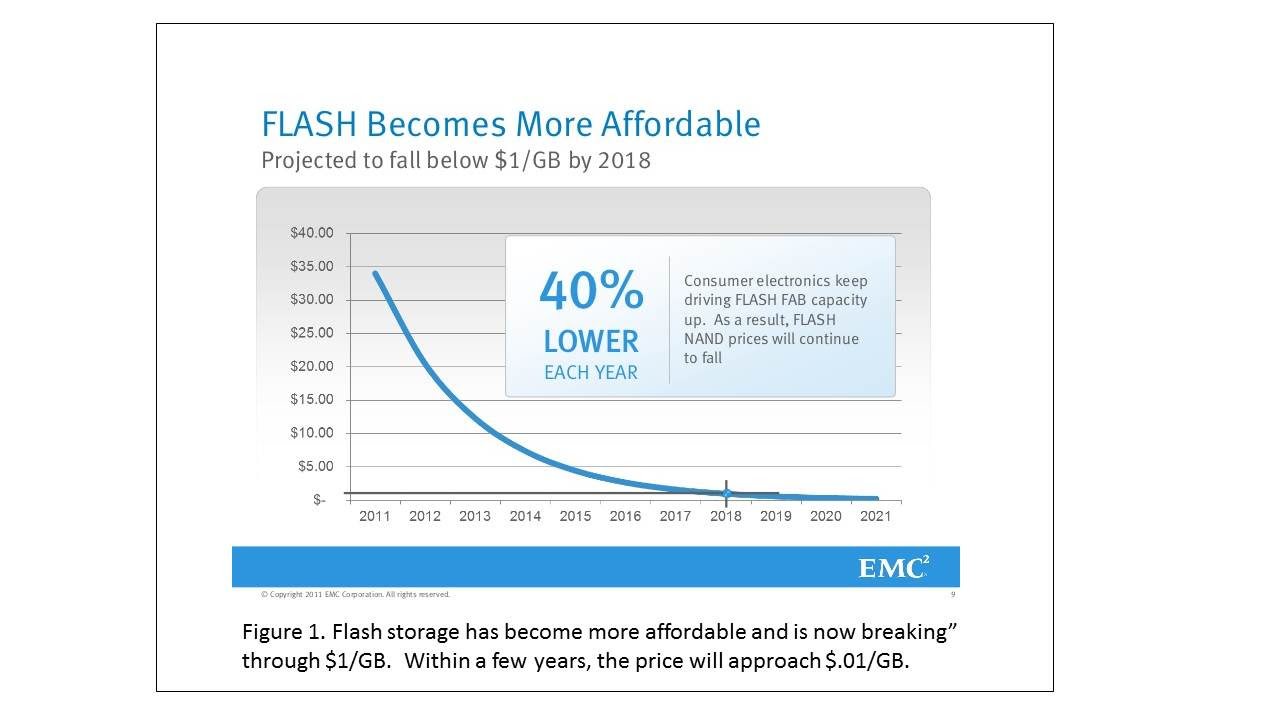Flash solid state storage is becoming more viable in mobile devices as price per GB continues to fall
Let me ask you a critical question: How much storage do you need in your mobile devices? 64 gigabytes? 128GB? More? How about 1 terabyte? The quick, shoot from the hip answer always seems to be more is better. As you’ll see below, that may not always be the right answer.
Let’s first look at a number of different mobile devices and what storage they offered – whether they used a hard disk drive or Flash. Then, we’ll look at the relative cost of HDD and flash. Finally, we’ll notice that even in laptops the trend is to only include the amount of storage you need to get the job done.
Flash vs. HDD in mobile devices
Do you remember buying an iPod Classic (circa 2001) that incorporated a 1.8-inch HDD with 5GB of storage for $349? The iPod Classic with a HDD continued until 2014 with 160GB of storage. Initially, the price per GB was high, but came down quickly so today the iPod Nano (small) and iPod Touch (size of an iPhone only thinner) all use flash storage with up to 128GB of storage.
The iPhone started with flash solid state storage and today includes up to 128GB of storage. The iPad always used flash and has up to 128GB of storage with likely larger values in coming years.
Have you noticed that while the price of iPhones stays the same from year to year, the amount of storage has just about doubled every two years? You can now get an iPhone with 128GB of storage with more likely over the coming years. The reason is the price of solid state flash storage is coming down almost every year.
This same trend is happening in laptops. Those that conform to the “ultrabook” form factor all use flash SSD with 128GB standard and options to increase that to 256GB and on high-end units to much more expensive 1TB. The standard today in notebooks with 512GB of storage or larger is to use a thin 2.5-inch HDD that can provide up to 1.5TB of storage.
But, will this ever-increasing amount of flash SSD storage in mobile devices continue? Even though it might be viable to put 256GB or 1TB of flash storage in an iPhone, iPad or MacBook, there are significant reasons discussed below why that may not be necessary.
Relative cost flash vs. HDD in mobile devices
The cost of flash has been significantly more expensive than HDD due to the relative cost of manufacturing flash on wafers in a flash factory. The cost of HDD is based on how dense the bits can be placed on a magnetic disk and how fast the read/write head can access any information located on the HDD. It’s a mechanical process.
Since it has been possible to reduce the size of the flash chip over time, it’s therefore possible to create more flash chips per wafer which, in turn, reduces the cost of the flash chip. The average cost reduction has amounted to about 40% a year as shown in figure 1.
As you can see in the diagram, the cost of flash was estimated in 2011 (the year EMC produced the graph) to fall below $1 per GB by 2018. Here it is early 2016, the cost is now below $1 per GB today at an average of 50 cents per GB. You can get a 128GB flash SD card for around $65. The cost reduction will continue to 1 cent per GB within a few years. Thus, 1TB storage will cost around $100.
Trends in future mobile device storage
We will reach the point that we can provide all the flash storage we want in a mobile device. The big question is, “how much storage do you need?”
I had an interesting conversation at CES with Ryan Smith of Samsung Microelectronics, the largest manufacturer of flash storage chips (that go into modules like SD cards and SSDs). We discussed the issue of how much storage is enough in mobile devices. We both agreed the requirements to operating systems, local data and applications will grow, but at a relatively low rate, perhaps something like 3% to 5% per year.
When we got to the data users own (e.g. music, photos, videos, Office files, etc.) that information is growing as fast or at times faster than the ability of user storage to handle it. I know I have two external hard drives just to store my videos (most of my wife Alicia’s riding in horse shows).
The advent of cloud storage from firms like Dropbox, Box, Apple, Microsoft and many others are typically providing 1TB or storage free (or at a low cost) in order for you to keep all your valuable data in the cloud. Thus, most of the storage you own may live in the cloud with your accessing only what you need at any one time.
This concept is slowly creeping into the storage system providers. For example, Dropbox for the iPhone and iPad keep all the metadata of your cloud data, but they only download a file when you request it. Thus, the storage needed on an iPhone or iPad is relatively modest. The laptop version of Dropbox syncs all of the user’s data to their local hard drive. However, you can override that by selecting only the folders you want to download.
I am at this juncture where I want to store significantly more information in the cloud than I need in any of my mobile devices at any one time. I have two external hard drives of photo data (in addition to the video data) I will upload to Dropbox, but then I’ll start designating only the files I need to keep on my local hard drive and sync a modest amount of information likely less than 256GB.
Thus, I can get a laptop with a smaller SSD than I have had in the past with a larger HDD. I will still get the highest capacity iPhone and iPad until I reach around 256GB to 512GB. At that time, I’ll access all the storage I need at any one time.
One by-product of getting all your data in the cloud is it also operates as an online backup of your data. Even so, once a year, I continue to copy the cloud storage to an external HDD just to have my own local copy.
I would recommend anyone who is going to buy a laptop today for normal productivity reasons (vs. gamers) to buy a laptop with a SSD. The disk won’t wear out like a HDD and it operates faster. It might cost a little more, but it is well worth it.
J. Gerry Purdy, Ph.D. is the principal analyst with Mobilocity LLC and a research affiliate with Frost & Sullivan. He is a nationally recognized industry authority who focuses on monitoring and analyzing emerging trends, technologies, and market behavior in mobile computing and wireless data communications devices, software and services. Dr. Purdy is an “edge of network” analyst looking at devices, applications and services as well as wireless connectivity to those devices. Dr. Purdy provides critical insights regarding mobile and wireless devices, wireless data communications, and connection to the infrastructure that powers the data in the wireless handheld. Dr. Purdy continues to be affiliated with the venture capital industry as well. He spent five years as a venture advisor for Diamondhead Ventures in Menlo Park where he identified, attracted and recommended investments in emerging companies in the mobile and wireless industry. He has had a prior affiliation with East Peak Advisors and, subsequently, following their acquisition, with FBR Capital Markets. Dr. Purdy advises young companies who are preparing to raise venture capital. Dr. Purdy has been a member of the Program Advisory Board of the Consumer Electronics Association that produces CES, one of the largest trade shows in the world. He is a frequent moderator at CTIA conferences and GSM Mobile World Congress. Prior to funding Mobilocity, Dr. Purdy was chief mobility analyst with Compass Intelligence. Prior to that, he owned MobileTrax, LLC and enjoyed successful stints at Frost & Sullivan, Dataquest (a division of Gartner) among other companies.
Editor’s Note: Welcome to Analyst Angle. We’ve collected a group of the industry’s leading analysts to give their outlook on the hot topics in the wireless industry.



